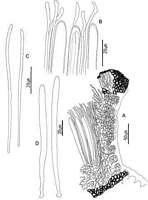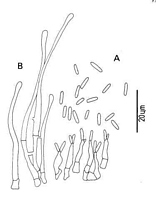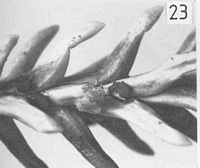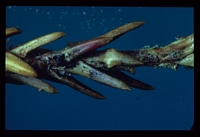|
 Coccomyces cupressini Coccomyces cupressini
BiostatusPresent in region - Indigenous. Endemic
Images (click to enlarge)
Caption: Fig. 4 Coccomyces cupressinum : A, ascocarp margin in cross-section. B, apices of asci and
paraphyses. C, released ascospores. D, asci. | 
Caption: Fig. 5 Anamorph of Coccomyces cupressinum: A, conidiogenous cells and conidia. B, sterile
elements found amongst conidiogenous cells. | 
Caption: Fig. 23 Macroscopic appearance of ascocarp (x 12).
C. cupressinum; | 
Owner: Herb. PDD | |
Article: Johnston, P.R. (1986). Rhytismataceae in New Zealand. 1. Some foliicolous species of Coccomyces de Notaris and Propolis (Fries) Corda. New Zealand Journal of Botany 24(1): 89-124 (http://www.rsnz.org/publish/abstracts.php).
Description: Ascocarps developing in pale brown lesions, on fallen leaves. Lesions not associated with
zone lines. Ascocarps round to broadly oval in outline, 0.4-0.8 mm diam. Immature walls
grey, pale grey, or concolorous with surrounding host tissue, darker around the edges with
well-developed, broad, paler zones along future lines of opening. Mature ascocarps opening
widely, either by a single slit, or by 3-4 radiate slits, walls pale with darker lines around edge
of opening and around other edge of ascocarp, no lip cells. Hymenium bright yellow.
Pycnidia present before ascocarps form, flat, lenticular, pale to dark grey.
Ascocarps intraepidermal. In vertical section upper stromatal layer 15-30 µm wide,
comprising pseudoparenchymatous, thin walled cells, 5-8 µm diam., cells dark brown to
carbonaceous around opening of ascocarp, paler brown near outer edge. An extra layer of
hyaline, gelatinous cells is present between the upper stromatal layer and the covering host
tissue in immature ascocarps. This layer is often not visible in mature ascocarps. Lower
stromatal layer separate from upper, 8-15 µm wide, of 2-4 layers of dark brown, thick
walled, globose cells, 4-10 µm diam. Subhymenium 10-15 µm wide, of hyaline, thin
walled cells. Layer of gelatinised tissue up to 40 µm wide developing between
subhymenium and lower stromatal layer, and sometimes also present on the inside of the
upper stromatal layer. Excipulum-like structure becoming well developed, arising from the
layer of gelatinised tissue, up to 40-80 µm wide, elements 1.5-2.5 µm diam., closely
septate and often capped by a dark brown substance.
Paraphyses 1.5-2 µm diam., gradually becoming wider toward apex, up to 2.5-4.5 µm
diam., not branching, extending 15-25 µm beyond asci. Asci 131-163 x 7- 10 µm,
cylindric, basal stalk short and broad, tapering to a rounded to slightly truncate apex. Ascus
wall slightly thickened at apex, 1.5-2 µm thick, with a small apical pore, non-amyloid, 8-spored. Ascospores 90-119 x 1.5-2.2 µm, tapering to basal end, 0-1 septate, straight when
released, well-developed gelatinous sheath.
Pycnidia intraepidermal, flat, lenticular in shape, lower wall of dark brown, angular cells,
upper wall absent or comprising a few, scattered, pale brown cells. Conidiogenous layer
lining the lower wall, comprising a palisade of solitary, cylindric to flask-shaped, hyaline,
sympodial, conidiogenous cells, 12-18 x 2-3 µm. Sterile elements, filiform and slightly
swollen at the apices, connected by hyphal bridges near bases, 45-80 x 2-2.5 µm, intermixed
with the conidiogenous cells. Conidia short-cylindric, rounded ends, hyaline, 0-septate, 4.5-6.5 x 1-1.2 µm.
Habitat: Found on recently fallen leaves of Dacrydium cupressinum.
Notes: ETYMOLOGY: cupressinum; refers to host plant.
The ascocarps of C. cupressinum look superficially similar to those of C. araucariae
Butin & Speer and C. radiatus Sherwood. C. araucariae (Brasil, Vossoroca, Porana, on
Araucaria angustifolia, H. Butin, E. Speer, 11.IX. 1976 - Holotype, ZT) differs in ascus and
ascospore size, and in excipular structure. C. radiatus lacks the layer of gelatinised tissue
found between the stroma and hymenium in C. cupressinum, has a different excipular
structure, and narrower asci.
Two rhytismataceous species have been described from Podocarpaceae - Hypoderma
podocarpi Butin from Podocarpus species in Chile (Butin 1970), and Lophodermellina
dacrydii Sydow from Dacrydium sp. in Borneo (Sydow 1921) but this is the first record of
Coccomyces on Podocarpaceae.
Also found on Dacrydium in New Zealand is a Hypoderma-like species. which is very similar
to Hypoderma podocarpi in ascocarp shape and appearance, with both having more or less
round ascocarps and white lip cells along the opening slits. The New Zealand species differs
from H. podocarpi in having larger asci and ascospores, and 4-spored asci.
|